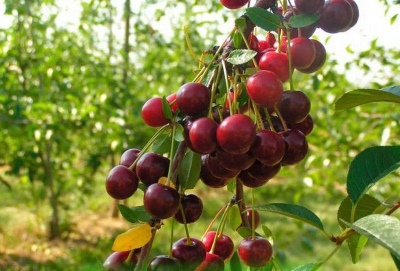
- Authors: Minnesota
- Appeared when crossing: English Morello x Serbian Pie
- Name synonyms: Northstar
- Barrel type: wood
- Growth type: low-growth, medium-sized
- Crown: thick, broadly round
- Leaves: matte, narrow oval
- Flowering and fruiting type: mixed
- Fruit size: average
- Fruit size, mm: 20 in diameter
Cherry Nord Star is a compact and early-growing variety that brings a large harvest. Differs in unpretentiousness and strong immunity. Berries are used for canning, making tinctures and preserves, dried fruits, jams.
Another name for the North Star.
Breeding history
The variety appeared in 1918 at an experimental station in the American state of Minnesota when the following species were cross-pollinated: English Morello and Serbian Pie.
Description of the variety
The tree is compact, weakly growing, up to 2-2.5 m, with a wide rounded dense crown. Branches are dark brown. Leaves are opaque, narrow, oval with a serrated edge, pointed. Flowering can begin in April or May. Flowers 2 cm in size are collected in inflorescences of 4 pcs. Fruits are tied on annual and perennial shoots. It has a low growth rate: only by the age of 10 it can reach a height of 2 m. Suitable for growing in intensive gardens.
Fruit characteristics
Berries of medium size, weighing 4.5-5 g, spherical, burgundy-red, the pulp is dense, juicy, aromatic, the stone is small, detachable. Stored for no more than 2 weeks in the refrigerator, in the cellar for about 10 days.
Taste qualities
Sweet and sour invigorating taste, sugar content - 9.2%, acids -1.5%. Tasting score 4 points.
Ripening and fruiting
The tree begins to bear fruit one year after planting. This is a medium late variety in terms of ripening: it begins bearing fruit in July, in some areas in August.
A mechanized harvesting method is possible.

Yield
Up to 15-20 kg can be removed from one tree, under favorable conditions up to 25 kg. 4-8 kg are harvested from a four-year-old plant.
Growing regions
Recommended for planting in central Russia, the North-West region, in the Volga region.
Self-fertility and the need for pollinators
Nord Star is partially self-fertile. Planting a number of other varieties increases yields. Cherries can become pollinators: Nephris, Meteor, Oblachinskaya, Volochaynaya, Apukhtinskaya, Zhukovskaya, Molodezhnaya, Lyubskaya, Turgenevka.
Landing
Planting work is carried out in April. In the southern regions, autumn planting is possible in mid-October. This cherry prefers open areas with good lighting and shallow groundwater. In the lowlands, they are planted on a special embankment. A hole is dug 50 cm deep, a mound of black soil is poured into it with the addition of organic matter, a seedling is installed, sprinkled with earth, watered, mulched. An interval of about 2 meters is left between the plants, 3 m between rows. In industrial cultivation, they are planted according to the scheme: 3x4 m. Seedlings are watered once a week with 20 liters of water. Then the skeletal branches are cut to 60 cm, and the side ones are shortened by 1/3.


Growing and care
Nord Star is a moisture-loving species. It is watered several times per season: in May during flowering, in June when berries ripen, in July after harvest, and in August. At one time, from 3 to 6 buckets of water are poured under the tree, depending on the weather and the frequency of rain. In summer, after watering, the soil must be loosened. In October, water-charging irrigation is carried out. Cherries are fed in the smallest doses. In the spring, fertilize with urea or calcium nitrate, in the fall, apply manure or compost. If the tree does not grow well, then at the end of the season it is fed with superphosphate. Mineral dressing, if necessary, is applied during watering in June.
The crown must be periodically thinned out, removing branches growing inward. Formative pruning is carried out in April or October. They are shaped like a bowl or a sparse-tiered scheme. Sanitary pruning is best done in the spring.


Disease and pest resistance
Cherry has good resistance to diseases and pests, especially resistant to coccomycosis and clasterosporium. It can be affected in some years by moniliosis. In case of manifestation of diseases, all affected areas are removed and sprayed with fungicides. Among insects, the moth, cherry sawfly and aphids are dangerous, preventive treatment is carried out in the spring in May before the beginning of flowering. For the prevention of pests and fungal diseases, they are treated in March and October with a solution of Bordeaux liquid.
Requirements for soil and climatic conditions
Winter hardiness of Nord Star cherry is high, withstands frosts from -30 degrees to -40. Young trees are completely covered for the winter. In regions with cold winters, the branches of an adult tree are bent in a circle or fan-shaped, wrapped in dense material, the trunk is wrapped in burlap or paper, the root system is protected with a layer of mulch, then a layer of snow. At the beginning of March, all insulation is removed. The variety can withstand heat and prolonged drought. From soils, it prefers light and medium-nutrient loams with neutral acidity and good moisture permeability.

Review overview
Gardeners note the unpretentiousness and undemandingness of this variety. Cherries grow and bear fruit even on impoverished soils. I really like the compactness of the tree, which does not shade the area around. Fruits are set even in rainy years, they are very good in compotes and jams.































































